Niech brzmienie ciszy sprawia Ci radość
Okiełznanie potęgi wiatru czyni żeglarstwo niezapomnianym przeżyciem. Chcesz słyszeć tylko odgłos wiejącego wiatru i łamiących się fal. Lecz jak najlepiej zapewnić zasilanie pokładowym urządzeniom elektronicznym, gdy silnik i generator są wyłączone? Victron łączy magazynowanie energii i jej wytwarzanie z paneli solarnych. W absolutnej ciszy.
Bez względu na to, czy wypływasz na weekendową wycieczkę, czy też planujesz rejs dookoła świata, te same urządzenia Victron mogą być pomocne w obydwu przypadkach. Jedynie poziom komfortu decyduje o optymalnym rozwiązaniu zastosowanym na pokładzie łodzi. Dzięki urządzeniom Victron można zasilić niemal wszystkie układy, lecz jako przykład podajemy „normalne” i „intensywne” profile mocy dla „przeciętnego” jachtu żaglowego.
Przyjrzyjmy się Twojemu Planowi Optymalnej Energii.
Produkcja na własny użytek
Ile potrzebujesz?
Współczesny jacht żaglowy wyposażony jest w ogromną ilość urządzeń elektrycznych. Większość z nich, koniecznych do prowadzenia jachtu, zasilana jest prądem stałym, natomiast większe urządzenia (AGD) wymagają prądu zmiennego. Gdy zachodzi potrzeba oszacowania poboru mocy, wiele osób po prostu dodaje moc w watach. Czas ma równie istotne znaczenie. Kuchenka mikrofalowa może pobierać 1000 Wat, lecz tylko przez 2 minuty. Lodówka może zużywać tylko 50 Wat, ale włączona jest przez 24 godziny na dobę.
Dla ilustracji przedstawiamy w skrócie 2 przykłady instalacji w oparciu o „normalną” i „intensywną” eksploatację.
1,2 - 2,4 kWh / dziennie
„normalne” i „intensywne” zużycie energii.Dowiedz się więcej
Dowiedz się więcejPrzykład 1
Kuchenka mikrofalowa zużywa 1000 W na godzinę, lecz włączona jest tylko przez 2 minuty dziennie.
1000 W / 60 x 2 = 0,03 kWh / 2 minuty
Przykład 2
Lodówka zużywa 50 W na godzinę, lecz włączona jest z przez cały dzień (faktycznie chłodzenie trwa przez ½ dnia ).
50 W x 24 godz./2 = 0,6 kWh / dziennie
Magazynowanie i przetwarzanie energii
Ile energii należy zmagazynować?
Magazynowanie energii umożliwia wykorzystywanie energii pobranej z zewnętrznego źródła podczas rejsu na pełnym morzu, lub zebranej za dnia energii solarnej w nocy. Inwertor przekształci zmagazynowaną energię na prąd 230 V. W jachtach żaglowych okresy pomiędzy ładowaniem akumulatorów są zwykle długie, zatem akumulator bytowy powinien mieć znaczną pojemność. Zgodnie z zasadą opartą na praktyce, wymaganą pojemność akumulatorów oblicza się na 48 godzin bez zasilania zewnętrznego. Chcąc uzyskać jeszcze większą niezależność, dzienne zużycie energii należy pomnożyć przez ilość dni.
x 2
Pojemność magazynowa akumulatora litowego powinna wynosić dwukrotność dziennego zużycia energii.
x 4
Z uwagi na ±50 % mniejszą obciążalność udarową, pojemność magazynowa akumulatora ołowiowo-kwasowego powinna być czterokrotnie większa od dobowego zużycia energii.
Przetwarzanie
Moc inwertora należy zaplanować tak, by nieprzerwanie dostarczał energii na średnim poziomie, oraz poradził sobie z oczekiwanym skokowym poborem mocy, z czym nasze inwertory radzą sobie doskonale (przeciętnie 2 x swojego prądu ciągłego).
Generowanie energii
Skąd pochodzi energia?
Źródła zasilania
Profil mocy


Normalne i intensywne profile zasilania w kWh, w oparciu o dzienne zużycie energii, które należy zrównoważyć ilością wytwarzanej energii.
Baterie akumulatorowe w Ah, podwójna pojemność przy korzystaniu z akumulatorów kwasowo-ołowiowych.
Schemat instalacji
dla instalacji z akumulatorami litowymi i kwasowo-ołowiowymi
W jaki sposób względy projektowe przekładają się na solidny system?

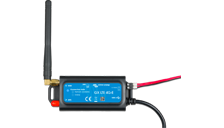
Moduły GX 4G
Moduł GX 4G uzupełnia Twój system Victron Energy o mobilną łączność internetową. Jeśli Twoja instalacja znajduje się w zasięgu sieci 4G, wyśle dane do witryny VRM, co umożliwi Ci monitorowanie systemu ze swojego smartfona. Moduł umożliwia również śledzenie GPS, rejestrację podróży i tworzenie ogrodzenia geograficznego wokół instalacji. O wszelkich zmianach otrzymasz powiadomienie na skrzynkę poczty elektronicznej.
Oferta firmy Victron Energy obejmuje szereg modułów 4G oraz modem GlobalLink 520, z którego korzystanie przez pierwszych pięć lat nie wiąże się z żadnymi miesięcznymi opłatami czy abonamentami. Poznaj nasze modemy 4G Poznaj nasz GlobalLink 520

Wybór profesjonalistów:
Zobacz, które monitory akumulatorowe są zalecana dla tego przykładowego systemu

AC devices
You’ll want to bring small devices on board for your trip. Or use household appliances like a microwave. These usually run of an AC outlet. Think of:
- Phone charger
- Laptop
- Television
- Refrigerator
- Microwave
Being able to plug-in these device saves you the trouble of finding a DC version.


Boat engines
Sailing yachts have one or two diesel engines (Catamarans) to get from harbour to horizon. The engines come with alternators to charge the engine batteries, drive fuel pumps, etc.
Once the starter batteries are recharged, the engines can also power the boat electrics and recharge the house battery. On bigger yachts you’ll find power hungry DC equipment such as anchor windlasses and bow thrusters. The engines have to be running before you can use them.

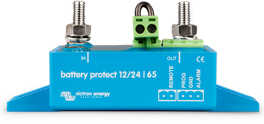
BatteryProtect
Discharging your battery too far will damage it. Adding a Victron BatteryProtect will disconnect the boat’s electronics when the battery voltage drops below a pre-set level. It will also automatically reconnect everything when the battery is sufficiently recharged.
There is more to a Victron BatteryProtect. The built-in shutdown delay ensures that vital electronics aren’t disconnected in error, i.e. when starting the engine causes a short drop in battery voltage.

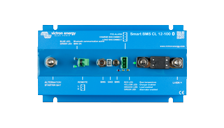
Battery Management Systems
Battery management systems take excellent care of Lithium batteries, protecting the individual cells of LiFePO4 batteries against over voltage, under voltage and over temperature and will shut down or reduce charging (VE.Bus products only) or disconnect the loads when this occurs.
Victron Energy offers several BMS options, in general the VE.Bus BMS and smallBMS signal separate devices to disconnect the charging (Inverter/Chargers, Cyrix-Li, DC-DC chargers) or disconnect the loads (BatteryProtect, Inverter/Charger), the modular Lynx distribution system features the Lynx BMS and other modules for more control over the DC busbar. For vehicles and boats all-in-one functionalities are available in the Smart BMS versions for Victron Lithium batteries, but also include current limiting to protect the alternator from overheating and BatteryProtect-like functionality to shut down the loads when pre-set critical battery conditions are met.
Victron Energy also offers full flexibility when it comes to selecting a third-party off-grid battery bank (and their BMS) of choice. A large number of well supported Lithium battery manufacturers can be easily integrated through the use of a mandatory GX-device. This flexibility enables our customers to perfectly match their off-grid needs for their unique power situation. When working with unsupported brands, a Victron Energy Battery Monitor is required to pass on accurate state of charge readings to the wider system.
Zobacz wszystkie nasze Systemy Zarządzania Akumulatorami
Wybór profesjonalistów:
Zobacz, które urządzenia zalecamy dla tego przykładowego sytemu
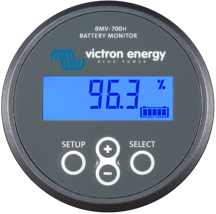
Monitory akumulatorowe
Monitor akumulatorowy działa jak „wskaźnik poziomu paliwa” dla akumulatora. Rejestruje ilość zużywanej i pobieranej energii. Monitor akumulatorowy oblicza stan naładowania, pozostałą pojemność i czas do wyczerpania. Napięcie akumulatora jest precyzyjnym wskazaniem jego poziomu naładowania (zwłaszcza, jeśli nie jest obciążony). Monitor akumulatorowy takie wskazania zapewnia.
Monitory akumulatorowe Victron Energy rejestrują takie dane historyczne, jak liczba cykli ładowania, najgłębsze rozładowanie, najwyższe napięcie, najniższe napięcie, itd. Monitor zaalarmuje o wystąpieniu warunków krytycznych, jak niskie napięcie lub niski poziom naładowania, a nawet może wyłączyć całe zasilanie, aby uniknąć kosztownego uszkodzenia akumulatora, lub uruchomić generator.
Victron oferuje monitory baterii z wyświetlaczem lub bez, wersje Smart umożliwiają śledzenie szczegółowych danych i dostosowywanie ustawień w naszej bezpłatnej aplikacji VictronConnect.
Większość instalacji z akumulatorami litowymi wymaga systemu zarządzania akumulatorami, który może przesyłać informacje do szerszego systemu. W tym układzie monitor akumulatorowy może się okazać zbędny. Więcej informacji podano w rozdziale System Zarządzania Akumulatorami. Zobacz nasze wszystkie monitory akumulatorowe

Wybór profesjonalistów:
Zobacz, które monitory akumulatorowe są zalecana dla tego przykładowego systemu
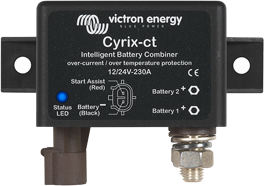
BatteryCombiner
The Cyrix BatteryCombiner is the only safe way to connect the house battery to the starter battery (to start your boat’s engines). With a BatteryCombiner you can charge the house battery from the alternator without running the risk of draining the starter battery (which always should be ready to go). When other sources of power are available (eg. shore/solar/generator power), the Cyrix BatteryCombiner will allow bi-directional charging from the house battery to the starter battery.
When the Voltages of the starter and house batteries are the same, use a Cyrix: its current rating should be equal or bigger than the current rating of the alternator. If the house battery is Lithium and the alternators Amperage is smaller than the house battery, or when the Voltages of the starter and house battery are different: use a Orion or Buck-Boost.


Boat Network
Keeping grips on all the systems on board can be a hassle. The solution: tie everything together in a single boat network using NMEA communication standards. Your boat network can include navigation equipment, tank senders, battery monitoring and much more. The status information can trigger alarms and shutdowns, adding to the safety on board. The Cerbo GX now supports the NMEA2000 out protocol, allowing you to monitor your boat’s network of systems from wherever you are.

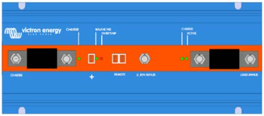
BMS 12/200
The BMS 12/200 is a dedicated battery management system (BMS) that protects Victron Smart 12,8V LFP batteries against deep discharges, overcharging and high temperatures with up to 200 Amps maximum DC current. When critical values are exceeded, the BMS acts immediately: loads are disconnected physically in case of a deep discharge and charging is stopped when there is a risk of overcharging. High temperatures trigger an immediate end to both charging and discharging.
This is the only BMS that can be directly connected to an alternator, protecting them from overload/overheating. This works with a combination of an AB fuse (rated in accordance with the expected max load current of the alternator) and an internal programmable input (which limits the input current electronically to 80% of the AB fuse).
Please check your manufacturer for the maximum charging current of your alternator and size AB fuses of the BMS 12/200 accordingly, see manual.
When different Lithium batteries & higher voltages are used, other solutions are needed, such as the VE.bus BMS and Lynx Ion BMS.
See our bigger boat types to see a bigger Lithium system and BMS See more info on alternator charging Lithium (and not blow them up)

Boat Electronics
A sailing yacht is home to several electronic devices. These are all connected to the house battery. Think of:
- Boat control panel
- Log/depth sounder
- Chart-plotter or GPS
- Navtex
- Auto pilot
- VHF Radio
- Navigation lights
- Pumps
- Windlass
- Bow thruster
- Fridge
- Interior lighting
- Music player

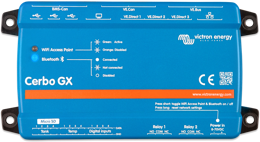
Cerbo GX
The Victron Cerbo GX is the communication-centre of your boat’s installation, allowing you to always have perfect control from wherever you are and maximises its performance. Simply connect through our Victron Remote Management (VRM) portal, or access directly, using the optional GX Touch 50 screen, a Multi Functional Display or our VictronConnect app thanks to its added Bluetooth capability.
The Victron Cerbo GX is an easy to use visual system. Instantly monitor the battery state of charge, power consumption, power harvest from PV, generator, and mains, or check tank levels and temperature measurements. Easily control the shore power input current limit, (auto)start/stop generator(s) or even set quiet periods to avoid starting the generator in the middle of the night. Change any setting to optimise the system, follow up on alerts, perform diagnostic checks and resolve challenges remotely. The Cerbo GX turns any power challenge into an effortless experience.

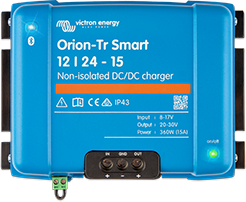
Ładowarki DC-DC
Przetwornice DC-DC lub ładowarki typu akumulator-akumulator (przetwornice z wbudowanymi algorytmami ładowania) są stosowane w systemach z dwoma akumulatorami, w których alternator (inteligentny) i akumulator rozruchowy są połączone z akumulatorem bytowym (o równych lub różnych napięciach). Mogą być również wykorzystywane do zasilania urządzeń wyposażonych w oddzielne akumulatory (np. sterów strumieniowych) lub wymagających napięcia innego, niż dostarczane przez baterię akumulatorów bytowych.
Większość ładowarek DC-DC można stosować w instalacjach 12 V lub 24 V, a wszystkie mogą współpracować zarówno z akumulatorami kwasowo-ołowiowymi, jak i litowymi. Niektóre modele ładowarek DC-DC można podłączyć równolegle, co zwiększa prąd wyjściowy. Ładowarki DC-DC to doskonałe i bezpieczne rozwiązanie do ładowania baterii akumulatorów litowych z inteligentnych alternatorów (a także akumulatorów kwasowo-ołowiowych).
Ładowanie akumulatorów litowych z alternatora
Większość alternatorów można bezpośrednio podłączyć do akumulatorów litowych. Akumulator litowy będzie pobierał więcej prądu, niż może dostarczyć alternator, co może spowodować trwałe uszkodzenie alternatora. Jedną z możliwości niedopuszczenia do takiej sytuacji jest ograniczenie prądu ładowania.
Victron oferuje wiele rozwiązań rozwiązujących ten problem, a jednym z nich są przetwornice DC-DC:
- DC-DC converters act as a current limiter between the alternator and the battery: the battery can be safely charged without blowing up the alternator.
- Victron also offers alternative solutions for dual battery systems powered by alternators. Some (smart) BMS products physically limit the current drawn from the alternator, in other systems, battery combiners might be a solid option. See the datasheets for more info.

Wybór profesjonalistów:
Zobacz, które z naszych ładowarek DC-DC są zalecane w tym przykładowym systemie
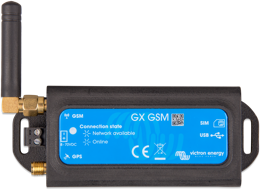
GX GSM Dongle
The Victron GX GSM is a 3G cellular modem that enables GX devices with mobile internet for the system and connection to the VRM Portal, allowing you to monitor your system from remote. When the boat is in range of a 3G network, it will send data to the VRM website and you can monitor the boat from your smartphone. The GSM module adds tracking the boat, recording your trips and putting up a geo-fence around the boat. You will get an alert via mail when the boat travels outside the geo-fence area.

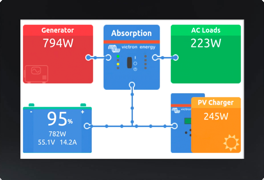
GX Touch
Victron Energy Cerbo GX to centrum łączności całej instalacji, które pozwala zawsze mieć pełną kontrolę nad systemem z dowolnego miejsca i zmaksymalizować jego wydajność. Opcjonalny GX Touch 50 jest uzupełnieniem Cerbo GX, ekran dotykowy o przekątnej pięciu cali zapewnia bezzwłoczny wgląd w parametry systemu i umożliwia dostosowanie ustawień w mgnieniu oka.
Bez żadnych opóźnień monitoruj stan naładowania akumulatorów, zużycie energii, pobór energii z paneli fotowoltaicznych, generatora i sieci energetycznej, lub sprawdzaj poziom paliwa zbiornikach i dokonuj pomiaru temperatury. Reguluj limit prądu wejściowego z zewnętrznego źródła zasilania, (automatycznie) uruchamiaj/wyłączaj generator(y), a nawet ustawiaj okresy ciszy, aby uniknąć uruchamiania generatora w środku nocy. Celem zoptymalizowania działania systemu zmieniaj dowolne ustawienia, śledź alerty, przeprowadzaj testy diagnostyczne i zdalnie rozwiązuj problemy za pomocą bezpłatnego portalu Victron Remote Management (VRM).
Cerbo GX to łatwy w obsłudze system wizualny, który zamienia każde wyzwanie związane z zasilaniem w zadanie nie wymagające żadnego wysiłku. Wystarczy połączyć się za pośrednictwem naszego portalu Victron Remote Management (VRM) lub uzyskać bezpośredni dostęp za pomocą opcjonalnego wyświetlacza GX Touch 50, wyświetlacza wielofunkcyjnego lub naszej aplikacji VictronConnect, co umożliwia dodana funkcja łączności Bluetooth.

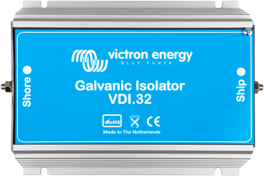
Galvanic Isolator
A galvanic isolator prevents electrolytic corrosion. The isolator is mounted directly behind the shore power connector on board. It blocks DC currents that might leak through the shore power earth terminal. These currents can cause corrosion to all metal parts under water, like the hull, propeller, shaft, etc. The galvanic isolator should have the same power rating as the incoming shore power.
It’s a misunderstanding that galvanic corrosion occurs only in metal and aluminium hulls. In fact it can occur on any boat as soon as a metallic part (the shaft and propeller) is in contact with water. Galvanic corrosion will quickly dissolve your sacrificial anodes, and attack the shaft, propeller and other metal parts in contact with water as soon as the boat is connected to the shore-side supply. It might therefore be tempting not to connect the ground conductor: this is however extremely dangerous because Ground Fault Current Interrupters will not work nor will a fuse blow in case of a short circuit to a metal part on the boat.
The safe option is to use a Galvanic Isolator for non-metal smaller boats, or use an isolation transformer for metal boats or boats with bigger systems.

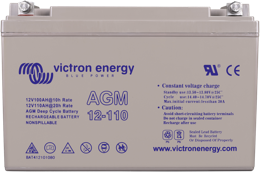
House battery
The house battery stores power for the boat’s electrical system. Sailing yachts typically have long intervals between battery recharges and the house battery should have a generous capacity.
For a house battery you can choose from two types: lead-acid and lithium. There are various reasons to favour one over the other. Here are a few common ones:
|
|

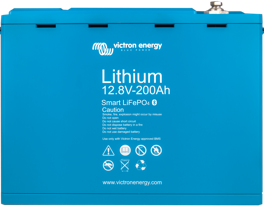
House battery
The house battery stores power for the boat’s electrical system. Sailing yachts typically have long intervals between battery recharges and the house battery should have a generous capacity.
For a house battery you can choose from two types: lead-acid and lithium. There are various reasons to favour one over the other. Here are a few common ones:
|
|

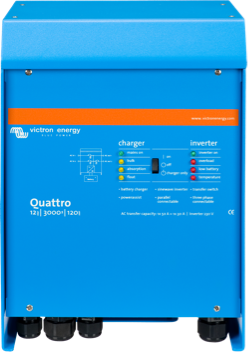
Inverter/Charger
The inverter/charger is the heart of the system. In the marina, it charges the batteries from shore power. While sailing it inverts the energy from the boat’s battery into AC power for household devices. The switch from charging to inverting and from inverting to charging is seamless.
- Victron inverter/chargers come with a handful of outstanding features:
- PowerControl: automatically manage battery charging to prevent an overload of the generator or shore power.
- PowerAssist: uses the battery as a buffer to assist the shore power during peak power demand.
- Perfect power: even sensitive devices run flawlessly on the pure sine wave power.
- High peak-power: use motorised equipment without overheating.
- Low self consumption.
For this power profile we would recommend:
We would recommend our Multiplus-II inverter/charger. If you have a generator on board you’ll need a Quattro inverter/charger, which has an extra input (shore power and generator).
We strongly recommend 24 Volts for new boats. The higher voltage is simply a better choice when it comes to meeting the power demands of a modern sailing yacht. If your boat’s system is based on 12 Volts, select a 12 Volts unit instead.

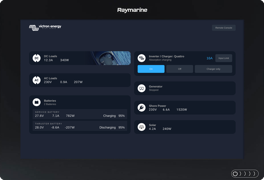
Integracja MFD GX
The Victron integration between our GX range and several leading Multi Functional Display manufacturer brands enables you to easily connect an MDF to the heart of your power system such as the Cerbo GX, or the GX enabled Multiplus-II GX. Once connected you can easily monitor and control your boat’s power system, right on your Glass Bridge.

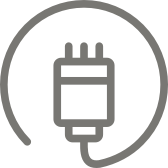
Shore Power
In the marina, the boat will be connected to shore power. Shore power recharges the batteries. It can also be used for maintenance and to run large AC loads.
Often shore power is limited in how much power you can draw, i.e. just 10 Amps. Berths with higher ratings might not always be available. Victron inverter/chargers allow you set a maximum shore power current. Now you can charge your batteries and turn on any equipment without blowing a fuse.
Sometimes shore power is less than perfect. You might run into voltage drops if you’re at the far end of the harbour. There could also be power surges, which could harm sensitive equipment on board. Victron’s inverter/chargers smooth out these problems and turn bad power into perfect power.

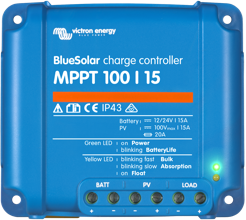
Solar charger
A solar charger- also called MPPT controller, harvests the power from the solar panels to charge the house battery. Solar chargers have the same charging cycles as our regular, fully automatic, battery chargers. When your boat is moored without shore spower, solar power is a great way to keep the batteries charged.
In a marine environment, the performance of solar panels changes constantly. Victron’s solar controllers use ultra fast maximum power point tracking to squeeze up to 30% more power out of your panels.
The rating of the solar charger is defined by the size of the solar panel. For solar panels of less than 150W or less, choose a 75/10 charger. If your solar panel produces between 150 and 220W, pick a 75/15 instead.
See our Solar Calculator to size the solar panels and select a MPPT charger
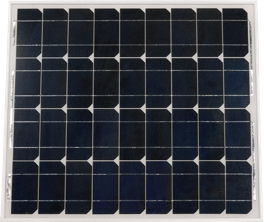
Solar panel
More and more sailing yachts area equipped with solar panels. After all, they extend the autonomy range without the noise of a diesel engine and… for free. Victron offers a wide range of small, highly efficient, solar panels that are just perfect for boats.
See our Solar Calculator to size the solar panels
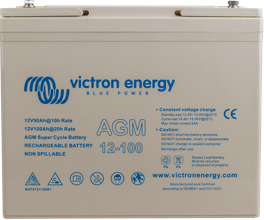
Starter Battery
The starter battery is needed to start your boat’s engine. These batteries are different from house batteries and engineered to deal with a large discharge current. The starter battery should always be ready to go. It’s best to isolate the important starter battery from all other electrical circuits on board, so it cannot be accidentally drained of power.

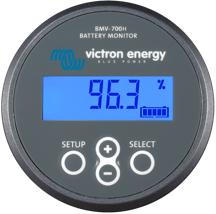
VE.Direct Bluetooth Smart dongle
The Bluetooth dongle enables you to use the VictronConnect app with VE.Direct enabled devices (without Bluetooth built-in). With the app you can have real-time insight and full control, and you can access all VE.Direct enabled devices such as the smaller VE.Direct inverters, the BMV 70x series battery monitors or MPPT solar controllers.

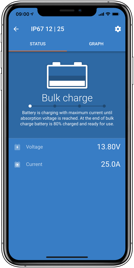
VictronConnect
All Victron products on your boat can be monitored and controlled from the palm of your hand. Just connect the VictronConnect App via Bluetooth and you’ll have direct access to values like battery voltage and current. You can also turn devices on or off, as well as change their settings.
See what the VictronConnect app can do

VRM - Victron Remote Management
Monitorowanie i zarządzanie
Monitoruj i zarządzaj systemami Victron Energy z dowolnego miejsca, dzięki możliwości konfiguracji alarmów potencjalne problemy wykrywaj na czas. Dzięki VRM masz zawsze nad wszystkim doskonałą kontrolę z dowolnego miejsca.
VRM współpracuje z urządzeniem GX, np. Cerbo GX z połączeniem internetowym, GlobalLink 520 lub GSM LTE 4-g w przypadku mniejszych instalacji.
Monitoruj
Monitoruj stan naładowania akumulatora, zużycie energii, uzysk energii z paneli słonecznych, generatora i sieci w czasie rzeczywistym. Zoptymalizuj uzysk i zużycie energii korzystając z danych historycznych i szczegółowych raportów analitycznych. Konfiguracja alarmów zapewnia wczesne wykrycie i reakcję na potencjalne problemy, co zapobiega poważnej awarii instalacji.
Zarządzaj
Kontroluj limity prądowe z brzegowego źródła zasilania, włączaj falownik, (automatycznie) uruchamiaj/wyłączaj generatory, a nawet ustawiaj okresy ciszy, aby uniknąć uruchamiania generatora w środku nocy. Korzystając z VRM możesz konfigurować wszystkie ustawienia, śledzić alarmy, przeprowadzać testy diagnostyczne i rozwiązywać problemy, a to wszystko z dowolnego miejsca na ziemi.
Zobacz nasze urządzenia GX
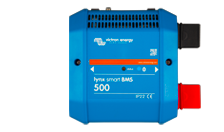
Lynx Smart BMS
Lynx Smart BMS to system zarządzania akumulatorami zaprojektowany specjalnie z myślą o inteligentnych akumulatorach litowych Victron (akumulatory litowe producentów innych niż Victron omówiono poniżej). Dla naszych baterii Smart Lithium dostępnych jest wiele modeli BMS-ów, lecz Lynx Smart jest urządzeniem oferującym najwięcej możliwości. Jego główne cechy to:
- Wbudowany stycznik 500 A służący jako awaryjny mechanizm bezpieczeństwa, który może również działać jako zdalnie sterowany główny wyłącznik systemowy.
- Monitor akumulatorowy, wskazujący, wśród innych danych, procentową wartość stanu naładowania.
- Sygnalizacja alarmu wstępnego: ostrzeżenie przed wyłączeniem systemu z powodu - na przykład - niskiego poziomu naładowania ogniwa.
- Łączność Bluetooth umożliwiająca konfigurację i monitorowanie systemu przez naszą aplikację VictronConnect.
- Lokalne i zdalne monitorowanie za pomocą urządzenia Victron GX, na przykład Cerbo GX.
System zarządzania akumulatorami
Specjalnie opracowany system zarządzania akumulatorami (BMS) chroni inteligentne akumulatory litowe Victron przed głębokim rozładowaniem, przeładowaniem i przegrzaniem. W przypadku przekroczenia wartości krytycznych BMS interweniuje niezwłocznie: chroniąc przed głębokim rozładowaniem akumulatorów następuje fizyczne odłączenie odbiorników energii, a w razie zaistnienia ryzyka przeładowania ładowanie zostaje przerwane. Wysokie temperatury powodują natychmiastowe przerwanie zarówno ładowania, jak i pobierania energii z akumulatorów.
Monitorowanie akumulatorów
Układ monitorowania akumulatorów jest wbudowany w Lynx Smart BMS; oddzielny monitor akumulatora nie jest potrzebny. Dzięki łączności Bluetooth, po podłączeniu do urządzenia GX baterię akumulatorową można monitorować przez VictronConnect, a także za pomocą VRM, naszego rozwiązania do zdalnego monitorowania.
System rozdziału Lynx
To urządzenie jest częścią modułowego systemu szyn zbiorczych Lynx, w skład którego wchodzi również rozdzielacz Lynx, czyli modułowa szyna zbiorcza DC z 4 bezpiecznikami DC, monitorująca ich stan przez VictronConnect i VRM, oraz pozostałe połączenia DC umożliwiając rozdział, ochronę bezpiecznikami, monitorowanie akumulatorów i/lub zarządzanie akumulatorami litowymi.
Akumulatory litowe producentów innych, niż Victron
Systemu szyn zbiorczych Lynx można również użyć do rozdziału prądu stałego i monitorowania akumulatorów litowych innych producentów. W takim przypadku należy wymienić Lynx Smart BMS na Lynx Shunt VE.Can umożliwiający monitorowanie innych akumulatorów. Zobacz wszystkie moduły Lynx

Wybór profesjonalistów:
Zobacz, które urządzenia zalecamy dla tego przykładowego sytemu
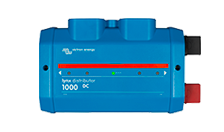
Lynx Distributor
The Lynx Distributor is a modular DC busbar, with locations for four DC fuses. It will monitor the status of each fuse, and indicate its condition with a LED on the front. When connected to a Lynx Smart BMS or Lynx Shunt, the status of the fuses will be visible in VictronConnect and VRM (when the Lynx Smart BMS is connected to a GX-device).
Multiple Lynx Distributors can be used to connect all the DC-loads and charge sources on one side of the BMS, on the other side, a Lynx Power In (without fuses) or another Lynx Distributor (with fuses) can be used to connect the battery bank to the modular busbar.
Lynx Distribution system
This product is part of the modular Lynx busbar system that also provides the Lynx Smart BMS, a dedicated Battery Management System for Victron Lithium Smart Batteries (for non Victron Lithium batteries, use the Lynx Shunt).
Zobacz wszystkie moduły Lynx
Wybór profesjonalistów:
Zobacz, które urządzenia zalecamy dla tego przykładowego sytemuIlość zużywanej energii jest różna na poszczególnych jachtach, nawet żaglowych, zależnie od potrzeb ich właścicieli. Oto dwa przykłady - z normalnym i intensywnym dziennym zużyciem energii - Planu Optymalnej Energii dla jachtu żaglowego. Prosimy zwrócić uwagę, że podczas planowania i montażu optymalnego rozwiązania należy wziąć pod uwagę większą ilość czynników: Twój Profesjonalista Victron z przyjemnością w tym pomoże.
Magia MultiPlus: mały generator, potężna moc.
Ocena eksperta: lit czy AGM na pokładzie?
Bezbłędne okablowanie dzięki podręcznikowi „Wiring Unlimited”
Pokaż więcej
Kontroluj wydajność swojego systemu przez swój Glass Bridge
Zobacz wszystkie nasze urządzenia Marine i ich konfiguracje.
Wgląd w czasie rzeczywistym i pełna kontrola dzięki naszej aplikacji VictronConnect
Znajdź lokalnego przedstawiciela handlowego
Profesjonaliści Victron, działający w ramach naszej globalnej sieci lokalnych ekspertów, z chęcią pomogą w zbudowaniu systemu optymalnego dla Twoich wymagań i planów.
Polegaj na naszym ogólnoświatowym serwisie
Zasadniczą sprawą dla nas wszystkich w firmie Victron jest to, by klientów obsługiwać i służyć im pomocą szybko i w kompetentny sposób. Dlatego Profesjonaliści Victron w naszej globalnej sieci znani są z najwyższego poziomu wiedzy oraz poświęcenia, by napraw dokonywać w możliwie najkrótszym czasie.
Możesz zatem rozpocząć lub kontynuować swoją podróż, bez względu na port docelowy.
